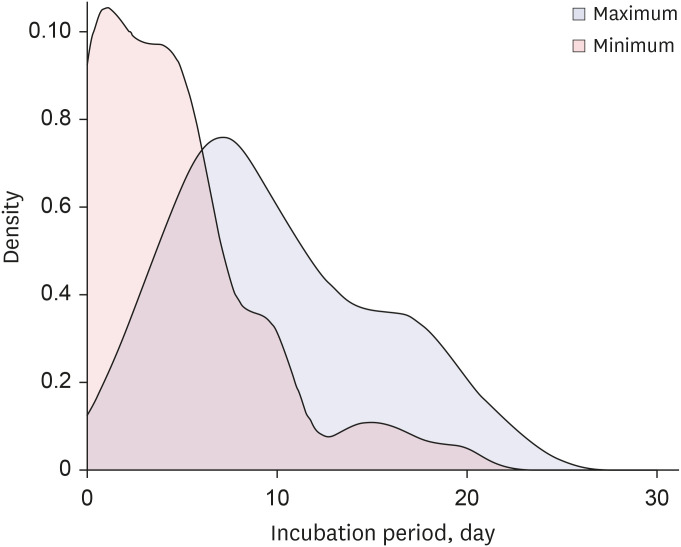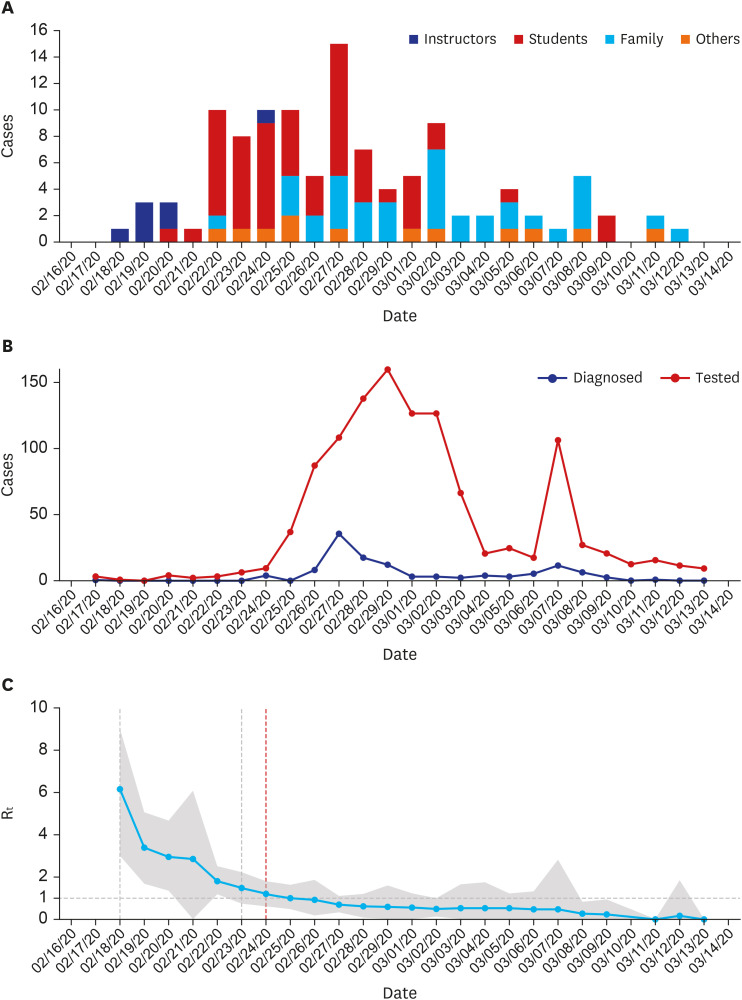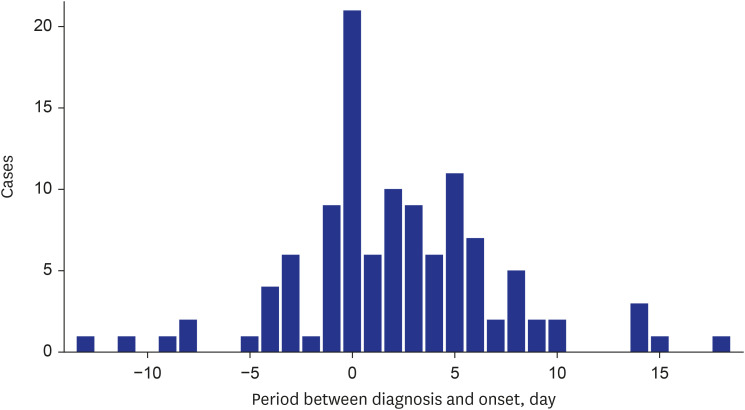J Korean Med Sci.
2020 Aug;35(31):e288. 10.3346/jkms.2020.35.e288.
Epidemiological Characteristics of COVID-19 Outbreak at Fitness Centers in Cheonan, Korea
- Affiliations
-
- 1Department of Preventive Medicine, College of Medicine, The Catholic University of Korea, Seoul, Korea
- 2Epidemiology & Case Management Team, COVID-19 National Emergency Response Center, Korea Centers for Disease Control and Prevention, Cheongju, Korea
- 3Chungnam Center for Infectious Diseases Control and Prevention, Hongseong, Korea
- 4Seosan Public Health Center, Seosan, Korea
- 5Department of Preventive Medicine, College of Medicine, Dankook University, Cheonan, Korea
- KMID: 2505202
- DOI: http://doi.org/10.3346/jkms.2020.35.e288
Abstract
- Background
In February 2020, a coronavirus disease 2019 (COVID-19) outbreak was reported in fitness centers in Cheonan, Korea.
Methods
From February 24 to March 13, an epidemiological investigation was conducted on the fitness center outbreak. All those who were screened were tested for severe acute respiratory syndrome coronavirus-2 (SARS CoV-2) using real-time reverse transcriptase polymerase chain reaction. Contacts were traced and self-isolated for 14 days. We determined the epidemiological characteristics of confirmed cases of SARS-CoV-2 infection, and estimated the time-dependent reproduction number to assess the transmission dynamics of the infection.
Results
A total of 116 cases were confirmed, and 1,687 contacts were traced. The source cases were 8 Zumba instructors who led aerobics classes in 10 fitness centers, and had the largest average number of contacts. A total of 57 Zumba class participants, 37 of their family members, and 14 other contacts were confirmed as cases. The attack rate was 7.3%. The contacts at Zumba classes and homes had a higher attack rate than other contacts. The mean serial interval (± standard deviation) were estimated to be 5.2 (± 3.8) days. The time-dependent reproduction number was estimated to be 6.1 at the beginning of the outbreak, but it dropped to less than 1, 2 days after the epidemiological investigation was launched.
Conclusion
The results suggest that the COVID-19 outbreak was effectively contained with rigorous contact tracing, isolating, and testing in combination with social distancing without a lock-down.
Figure
Reference
-
1. U.S. Food and Drug Administration. Accelerated emergency use authorization (EUA) summary. SARS-CoV-2 assay (Rutgers Clinical Genomics Laboratory). Updated 2020. Accessed August 5, 2020. https://www.fda.gov/media/136875/download.2. Kim JY, Choe PG, Oh Y, Oh KJ, Kim J, Park SJ, et al. The first case of 2019 novel coronavirus pneumonia imported into Korea from Wuhan, China: implication for infection prevention and control measures. J Korean Med Sci. 2020; 35(5):e61. PMID: 32030925.
Article3. Korean Society of Infectious Diseases. Korean Society of Pediatric Infectious Diseases. Korean Society of Epidemiology. Korean Society for Antimicrobial Therapy. Korean Society for Healthcare-associated Infection Control and Prevention. Korea Centers for Disease Control and Prevention. Report on the epidemiological features of coronavirus disease 2019 (COVID-19) outbreak in the Republic of Korea from January 19 to March 2, 2020. J Korean Med Sci. 2020; 35(10):e112. PMID: 32174069.4. Chungnam Center for Infectious Disease Control and Prevention. Epidemiology & Case Management Team. Covid-19 National Emergency Response Center. Korea Centers for Disease Control and Prevention. . Investigation of COVID-19 outbreaks through Zumba dance classes in Korea. Public Heal Wkly Rep. 2020; 13(16):998–1005.5. Micallef C. The effectiveness of an 8-week Zumba programme for weight reduction in a group of Maltese overweight and obese women. Sport Sci Health. 2014; 10(3):211–217.
Article6. Ubago-Guisado E, Sánchez Sánchez J, Vila Maldonado S, Gallardo L. Effects of Zumba® and aquagym on bone mass in inactive middle-aged women. Medicina (Kaunas). 2019; 55(1):1–10.
Article7. Domene PA, Moir HJ, Pummell E, Knox A, Easton C. The health-enhancing efficacy of Zumba® fitness: an 8-week randomised controlled study. J Sports Sci. 2016; 34(15):1396–1404. PMID: 26571136.
Article8. Barranco-Ruiz Y, Ramírez-Vélez R, Martínez-Amat A, Villa-González E. Effect of two choreographed fitness group-workouts on the body composition, cardiovascular and metabolic health of sedentary female workers. Int J Environ Res Public Health. 2019; 16(24):1–12.
Article9. Luettgen M, Foster C, Doberstein S, Mikat R, Porcari J. Zumba(®): is the “fitness-party” a good workout? J Sports Sci Med. 2012; 11(2):357–358. PMID: 24137072.10. World Health Organization. Report of the WHO-China Joint Mission on Coronavirus Disease 2019 (COVID-19). Geneva: World Health Organization;2020.11. Jang S, Han SH, Rhee JY. Cluster of coronavirus disease associated with fitness dance classes, South Korea. Emerg Infect Dis. 2020; 26(8):1917–1920. PMID: 32412896.
Article12. Boelle PY, Obadia T. R0: Estimation of R0 and Real-Time Reproduction Number from Epidemics. Vienna: R Foundation for Statistical Computing;2015.13. R Core Team. R: a Language and Environment for Statistical Computing. Vienna: R Foundation for Statistical Computing;2020.14. Park SY, Kim YM, Yi S, Lee S, Na BJ, Kim CB, et al. Coronavirus disease outbreak in call center, South Korea. Emerg Infect Dis. 2020; 26(8):1666–1670. PMID: 32324530.
Article15. Li Q, Guan X, Wu P, Wang X, Zhou L, Tong Y, et al. Early transmission dynamics in Wuhan, China, of novel coronavirus-infected pneumonia. N Engl J Med. 2020; 382(13):1199–1207. PMID: 31995857.16. Ki M. Task Force for 2019-nCoV. Epidemiologic characteristics of early cases with 2019 novel coronavirus (2019-nCoV) disease in Korea. Epidemiol Health. 2020; 42:e2020007. PMID: 32035431.
Article17. Nishiura H, Linton NM, Akhmetzhanov AR. Serial interval of novel coronavirus (COVID-19) infections. Int J Infect Dis. 2020; 93:284–286. PMID: 32145466.
Article18. Guan WJ, Ni ZY, Hu Y, Liang WH, Ou CQ, He JX, et al. Clinical characteristics of coronavirus disease 2019 in China. N Engl J Med. 2020; 382(18):1708–1720. PMID: 32109013.19. Pan A, Liu L, Wang C, Guo H, Hao X, Wang Q, et al. Association of public health interventions with the epidemiology of the COVID-19 outbreak in Wuhan, China. JAMA. 2020; 323(19):1–9.
Article
- Full Text Links
- Actions
-
Cited
- CITED
-
- Close
- Share
- Similar articles
-
- Clinical and Epidemiological Characteristics of Coronavirus Disease 2019 in the Early Stage of Outbreak
- Cardiovascular Imaging Asia in the Era of the COVID-19 Outbreak
- Report on the Epidemiological Features of Coronavirus Disease 2019 (COVID-19) Outbreak in the Republic of Korea from January 19 to March 2, 2020
- Epidemiological characteristics of a COVID-19 outbreak caused by religious activities in Daegu, Korea
- Outbreak investigation: transmission of COVID-19 started from a spa facility in a local community in Korea




